You'll need several essential tools to create alcohol-based perfumes professionally: a digital scale measuring to 0.01g, borosilicate glass beakers, clean pipettes, and dark glass bottles for storage. Don't forget safety gear like nitrile gloves and protective eyewear. A well-organized workspace with proper documentation materials helps track your formulas. To elevate your perfumery skills, quality control equipment like pH meters and fragrance blotters will reveal new possibilities in scent creation.
Essential Measuring Equipment for Perfect Proportions

When creating perfumes, precise measurements can make the difference between a masterpiece and a mishap. You'll need a digital scale that measures down to 0.01 or 0.00 grams to guarantee accurate ingredient proportions and consistent formula replication.
For handling liquids, you'll require borosilicate glass beakers and graduated cylinders. Remember to clean them with soapy water and sterilize with ethanol before use. Since alcohol concentration significantly affects fragrance quality, proper measuring tools are essential for achieving the right proportions.
Don't forget pipettes and droppers for managing small quantities and achieving precise drop-by-drop measurements, especially during the dilution phase.
Temperature-sensitive ingredients demand a reliable thermometer, while separatory funnels help divide essential oils from hydrosol.
You'll also benefit from stainless steel funnels, strainers, and trays for filtering and safe handling of mixtures.
When working with thick aromatics like labdanum, wax-carving tools prove invaluable.
Storage Solutions for Ingredients and Final Products
Proper storage can extend the life of your perfumes and raw materials by several years.
You'll need to store your creations in a cool, dark place away from humidity and temperature fluctuations. Keep your fragrances in their original packaging or dark glass bottles with tight seals to protect them from light and air exposure.
For raw materials, invest in tiered racks that separate ingredients by dilution levels, making them easier to access when you're blending. Anti-slip bases will help prevent accidents when reaching for ingredients during the creative process.
Consider using a dedicated mini fridge for extensive collections, or create a customized storage unit using a repurposed cabinet.
Avoid plastic containers, as they'll reduce shelf life. Instead, opt for airtight glass bottles and organize them in perfume storage boxes that shield your precious creations from environmental factors.
Mixing and Blending Tools for Smooth Formulations
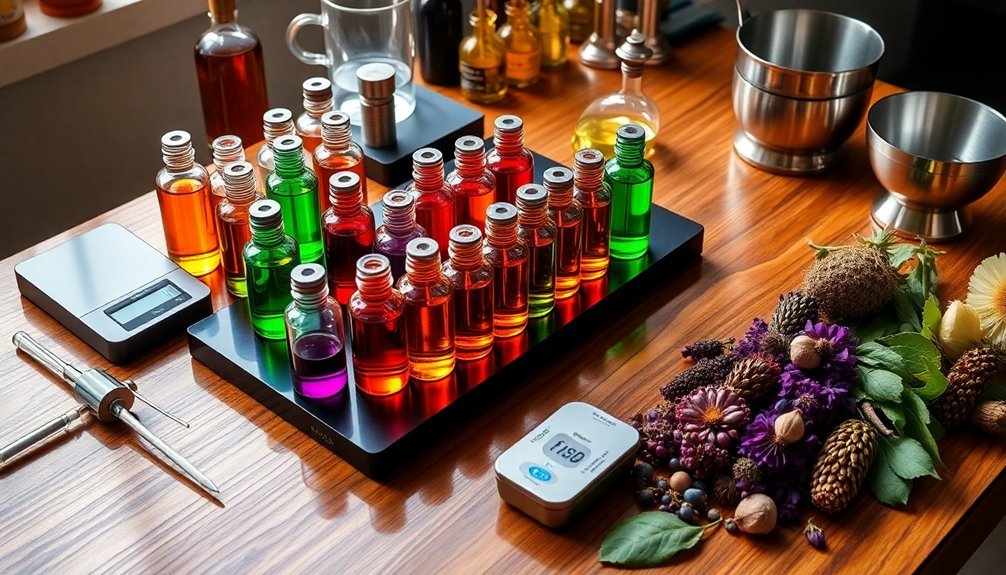
Creating smooth, balanced perfumes requires a specific set of mixing and blending tools that work together seamlessly. You'll need fragrance blotters for sampling and comparing different scent profiles, along with digital scales to guarantee precise measurements of your ingredients.
For liquid transfers, you'll want pipettes in both disposable and glass options to handle your fragrance oils accurately. Glass beakers and bottles are essential for mixing and storing your formulations. A reusable bottle kit helps ensure proper blending when combining multiple scents.
| Tool Type | Primary Use | Key Feature |
|---|---|---|
| Blotters | Scent evaluation | Compare profiles |
| Scales | Weight measurement | Precise control |
| Pipettes | Liquid transfer | Accuracy |
| Beakers | Mixing | Durability |
| Bottles | Storage | Reusability |
These tools will help you maintain consistency in your perfume creation process while guaranteeing professional-quality results in every blend you make.
Safety Gear for Protection During Perfume Making
When working with perfume ingredients, you'll need proper protective equipment like gloves, goggles, and a lab coat to shield yourself from potential chemical hazards.
Your workspace must include emergency response tools, including eyewash stations and first aid kits, readily accessible for immediate use in case of accidents.
You'll also want to establish clear chemical handling protocols, including proper ventilation and spill containment measures, to maintain a safe working environment.
Essential Personal Protective Equipment
Safety in perfume making requires extensive personal protective equipment to shield you from potentially hazardous materials and chemical exposure. You'll need proper clothing, hand protection, eye safety gear, and respiratory equipment to work safely with perfume ingredients.
| Protection Type | What You Need |
|---|---|
| Clothing | Lab coat & chemical-resistant apron |
| Hands | Nitrile gloves (avoid latex) |
| Eyes/Face | Safety goggles & face shield |
| Respiratory | Half-mask respirator with organic vapor filters |
Always wear closed-toe shoes and long sleeves to minimize skin exposure. Your nitrile gloves should fit well for maximum dexterity, and you'll need to inspect them regularly for tears. Make sure your respirator has a proper seal and fresh filters. Don't forget to keep an eye wash station nearby and work in a well-ventilated area to reduce respiratory risks.
Chemical Handling Safety Protocol
Proper chemical handling protocols form the foundation of safe perfume making.
You'll need to work on non-reactive, easy-to-clean surfaces to prevent chemical absorption from accidental spills. Always store your essential oils and aroma chemicals in closed cabinets to avoid unwanted exposure.
Maintain good ventilation with exhaust fans that provide 6 air changes per hour or 1 CFM per square foot of storage space. Use bell jars or similar containers to control fragrance vapors.
Keep denatured alcohol and other chemicals away from direct skin contact, and only use cosmetic or food-grade materials.
Install an emergency shower system that maintains water at 20-25°C for immediate accident response.
Keep your workspace clean and organized, following written procedures for cleaning schedules and responsibilities to prevent contamination and guarantee proper ventilation.
Emergency Response Tools Ready
Equipped perfumers must maintain a complete set of emergency response tools for immediate access during accidents or spills.
You'll need an emergency shower system with a heated water tank that maintains temperatures between 20-25°C, positioned near your loading areas for quick access.
For personal protection, keep nitrile gloves, safety goggles, and lab coats readily available.
Don't forget to include a properly stocked first aid kit with eye baths for chemical flushing.
You'll also want protective masks rated for oil vapors and plastic aprons for additional protection against spills.
Store a detailed safety data sheet near your workstation for quick reference during emergencies.
Make sure you've installed proper ventilation systems and keep emergency contact numbers visible.
Glass Containers and Bottles for Professional Results
When creating professional perfumes, glass containers and bottles serve as the foundation for both storing and presenting your fragrances.
You'll find that glass is the superior choice because it doesn't react with your perfume ingredients, ensuring your scents remain pure and unadulterated.
Whether you're working with 15ml, 30ml, or 50ml capacities, you'll need a variety of containers for different stages of your perfume-making process.
- Choose lead-free glass bottles to meet safety regulations
- Select amber or green glass for light-sensitive formulations
- Consider bottles with orifice reducers for controlled dispensing
- Invest in airtight closures to maintain fragrance integrity
- Look for spray atomizers or roll-on options based on your application needs
Always inspect your glass containers for defects before use, as quality control is essential for professional results.
Precision Instruments for Accurate Measurements
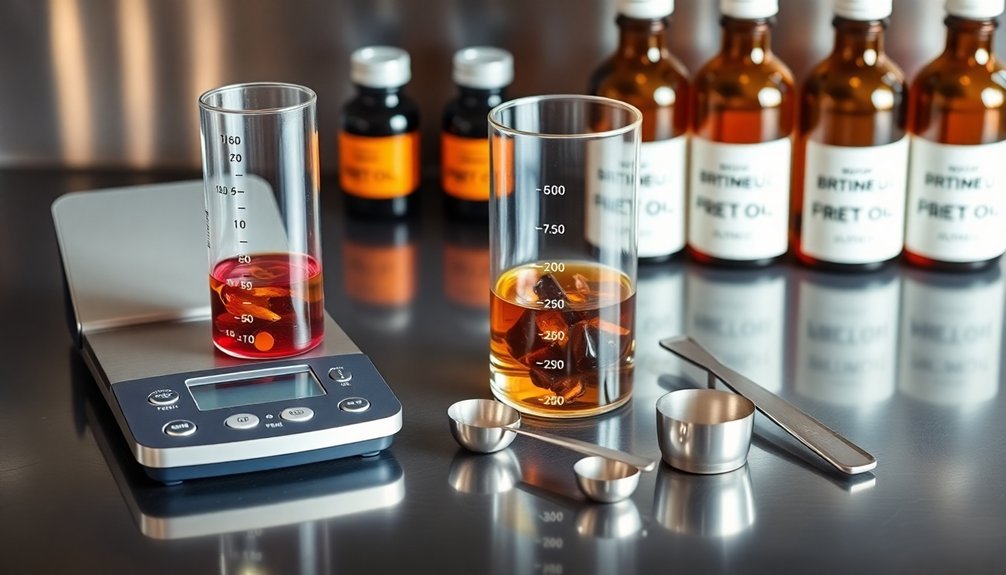
Professional perfume creation demands meticulous attention to measurement, and precision instruments serve as your key to consistent, reliable formulations.
You'll need a high-accuracy digital scale with ±0.003g precision for weighing ingredients. Choose a laboratory-grade analytical balance that displays measurements to the hundredths, and remember to calibrate it regularly.
For temperature control, opt for a digital thermometer that's compatible with your materials and easy to sterilize.
Your pipette selection should include both disposable plastic ones for everyday use and glass Pasteur pipettes for heat-resistant applications. Make sure they're graduated for precise measurements.
Don't forget to include a TDS meter in your toolkit – it's an inexpensive yet valuable tool for monitoring alcohol saturation when working with botanical extractions, helping you determine when your tinctures are ready.
Transfer Tools and Equipment for Clean Handling
When working with perfumes, you'll need high-quality funnels to pour ingredients without spills, along with clean pipettes and droppers for precise measurements and transfers.
Your glass transfer tools, including graduated pipettes and bulb transfer devices, guarantee accurate dispensing while maintaining the purity of your fragrances.
Stainless steel equipment, from funnels to strainers, offers durability and easy cleaning while preventing contamination during the perfume-making process.
Essential Funnels For Pouring
While creating your own perfumes can be exciting, having the right transfer tools is crucial for clean and precise handling. You'll need high-quality funnels to guarantee accurate pouring and prevent costly spills.
Choose between stainless steel for precision, transparent options for visibility, or borosilicate glass for chemical resistance. Always work over a sink and keep your funnels clean to avoid cross-contamination.
Here's what you need to know about funnel selection:
- Stainless steel funnels offer durability and precision for everyday use
- Mini funnels work perfectly for small volumes of perfume and essential oils
- Transparent options help you monitor liquid flow more effectively
- Borosilicate glass resists chemical damage and maintains purity
- Use separate funnels for different fragrances to prevent mixing scents
Clean Pipettes And Droppers
Maintaining pristine pipettes and droppers is essential for creating pure, uncontaminated perfumes. You'll need to rinse them with alcohol immediately after use to remove residual oils, followed by a thorough cleaning with mild dish soap and hot water.
Don't forget to use a bottle brush for hard-to-reach areas. For stubborn residues, you can use 70% or 91% isopropyl alcohol as an effective solvent. Vinegar and baking soda serve as gentle yet powerful cleaning alternatives.
When cleaning's complete, rinse with distilled water to prevent mineral deposits. After washing, let your tools air dry completely in a clean environment.
You'll want to inspect them regularly for wear and damage. Store your clean pipettes and droppers in a designated space to maintain their sterility for your next perfume-making session.
Glass Transfer Tools Matter
Beyond clean pipettes and droppers, your perfume-making success depends heavily on quality glass transfer tools.
You'll need a thorough set of borosilicate glass equipment to guarantee accurate measurements and contamination-free handling of your precious ingredients.
- Glass measuring cylinders provide precise volume measurements for your raw materials
- Borosilicate beakers resist thermal shock and offer superior durability for mixing ingredients
- Glass flasks maintain ingredient purity while providing excellent storage and blending capabilities
- Glass funnels, when paired with filter papers, effectively remove unwanted particles from your concentrate
- Glass measuring spoons deliver accuracy for small quantity measurements of potent ingredients
When selecting your glass tools, don't compromise on quality – borosilicate glass is worth the investment as it prevents chemical reactions and maintains the integrity of your perfume formulations.
Documentation Materials for Recipe Recording
Just as a chef relies on detailed recipes, successful perfume creation depends on thorough documentation.
You'll need basic writing tools like pens, notebooks, and a label maker to record your formulas and identify your bottles. A digital scale with 0.01g accuracy is essential for precise measurements, along with graduated cylinders and droppers for liquids.
Keep your recipes organized in binders or digital spreadsheets, and take photos of your ingredients and final products for reference.
You'll find it helpful to use index cards for quick access to frequently used formulas. Consider using cloud storage to back up your recipes and join online perfume communities to share your creations.
Don't forget to maintain a catalog of your fragrance oils and their characteristics for future reference.
Filtration Systems for Crystal Clear Results
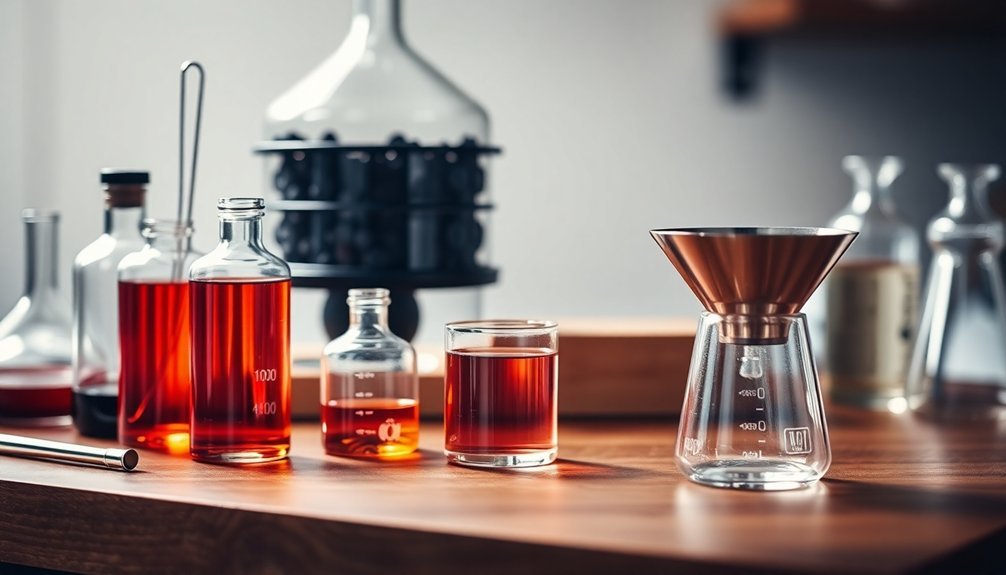
To achieve professional-quality perfumes, you'll need reliable filtration systems that guarantee crystal-clear results.
Your filtration setup should include both ethanol and essential oil processing capabilities, using activated carbon to remove unwanted odors and impurities from both components.
For peak results, you'll want to invest in these essential filtration tools:
- Two-stage microfiltration units with ratings between 0.65 and 100 microns
- Stainless steel strainers and funnels for tincture processing
- Separatory funnels to divide essential oils from hydrosols
- COAX® Series Filter Cartridges with polypropylene materials
- Pleated filters with polyethersulfone membrane for final polishing
Consider using depth filtration methods for both alcohol and oil preparations, and don't forget to incorporate freezing techniques when needed for additional clarity.
These systems will guarantee your final product is free from particulates and unwanted residues.
Quality Control Equipment for Testing
You'll need reliable pH testing devices to guarantee your perfume formulations maintain proper chemical balance and stability across different batches.
Modern solubility analysis tools help you quickly determine how well your fragrance compounds dissolve in various carrier solutions.
These essential quality control instruments let you catch potential issues before they affect your final product, saving both time and resources.
Ph Testing Devices
The journey into perfume quality control begins with reliable pH testing devices, essential tools for ensuring product stability and safety.
While pH strips offer an economical starting point for beginners, they'll only provide rough estimates. For professional perfume creation, you'll need a precise pH meter that can measure to one decimal point.
- Calibrate your pH meter regularly to maintain accuracy and reliability
- Prepare samples by diluting your perfume (10% product, 90% distilled water)
- Clean and store your testing devices properly after each use
- Consider investing in an emulsion probe if you're working with complex formulations
- Keep pH strips as backup tools for quick preliminary checks
Remember that proper pH testing isn't just about precision – it's vital for product stability, preservation effectiveness, and meeting quality control standards in commercial perfume production.
Solubility Analysis Tools
Beyond pH testing, proper solubility analysis serves as your next line of defense in perfume quality control.
You'll need specific tools to guarantee your fragrance compounds remain stable and properly dissolved in your alcohol base.
Start with high-resolution GC-FID instrumentation, particularly using columns like the Agilent J&W DB-HeavyWAX, to analyze your fragrance mixtures.
You'll want to dilute your samples in acetone before testing, adjusting concentrations as needed.
When working with water-soluble components, keep organic propanediol handy as a solubilizer to prevent separation.
To maintain accuracy, you'll need precision measuring tools including digital scales and glass cylinders.
Don't forget to verify your results using testing strips and monitor retention times.
For consistent documentation, use analysis software like Agilent OpenLab 2.2 to track your solubility test results.
Workspace Organization Tools and Storage

Maintaining an organized perfumery workspace allows you to focus on the creative process without hunting for essential tools and materials.
You'll need storage solutions that keep your ingredients accessible while protecting them from light and environmental factors. A well-designed perfumer's organ, whether custom-built or using rolling carts with drawers, forms the heart of your workspace.
Essential organization tools include:
- Stainless steel trays for surface protection during pouring and mixing
- Adhesive labels for clear identification of bottles and containers
- Scent strip holders with clips for efficient evaluation
- Rolling storage carts with categorized drawers for different material types
- Racks and palettes to keep project-specific materials within reach
Keep your frequently used items closest to your work area, and maintain separate storage zones for different material types like solids, absolutes, and dilutions.
Frequently Asked Questions
How Long Does Alcohol-Based Perfume Last Before the Scent Starts to Fade?
Your alcohol-based perfume's longevity depends on its concentration. You'll get 8+ hours from pure perfumes, 6-8 hours from EDP, and shorter durations from EDT and EDC due to their lower oil content.
Can I Use Regular Vodka Instead of Perfumer's Alcohol?
You shouldn't use vodka for perfumes. Its 40% alcohol content is too low, and high water content will weaken your fragrance. Instead, use perfumer's alcohol or Everclear 190 proof with 95% ethanol concentration.
What's the Ideal Room Temperature for Making Perfumes at Home?
You'll want to work in a room that's between 60-70°F (15-21°C). Keep the temperature steady while making your perfumes, as consistency helps maintain the stability of your fragrance ingredients.
How Do You Test Perfume Formulations for Allergic Reactions?
You'll need professional patch testing for safety. Don't test perfumes directly on skin at home. Instead, work with certified labs that can analyze your formulations for the 26 regulated allergenic ingredients.
Which Natural Ingredients Should Never Be Mixed in Alcohol-Based Perfumes?
You shouldn't mix unstable citrus oils, water-based botanicals, or excessive amounts of natural oils in alcohol-based perfumes. They'll separate, degrade quickly, or create cloudy mixtures that won't maintain their fragrance stability.
In Summary
As you've learned, creating alcohol-based perfumes requires the right tools and equipment for success. You'll need precise measuring instruments, proper storage containers, quality blending tools, and essential safety gear to craft your fragrances. Don't forget to maintain detailed records and invest in filtration systems for professional results. With these tools at your disposal, you're ready to begin your perfume-making journey.


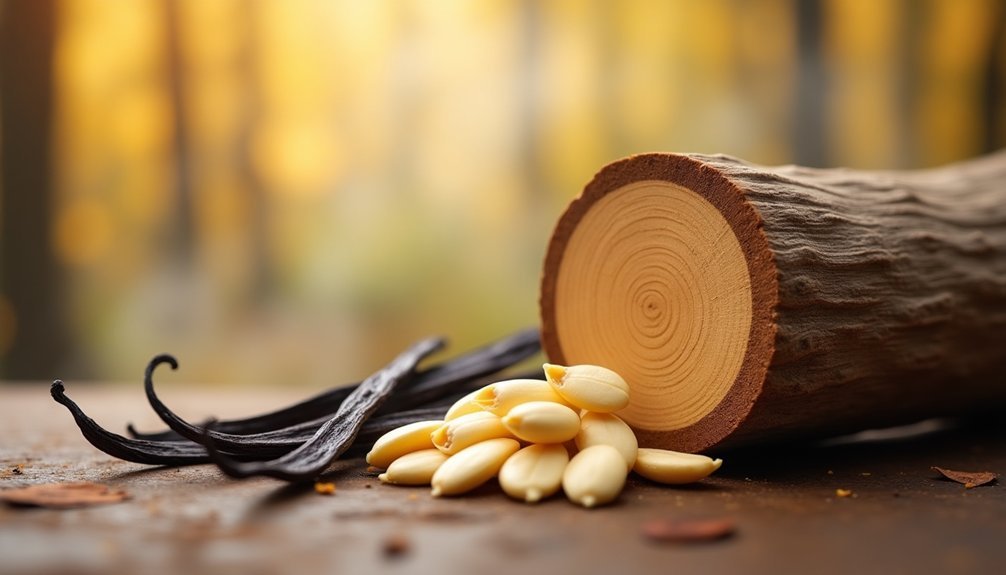
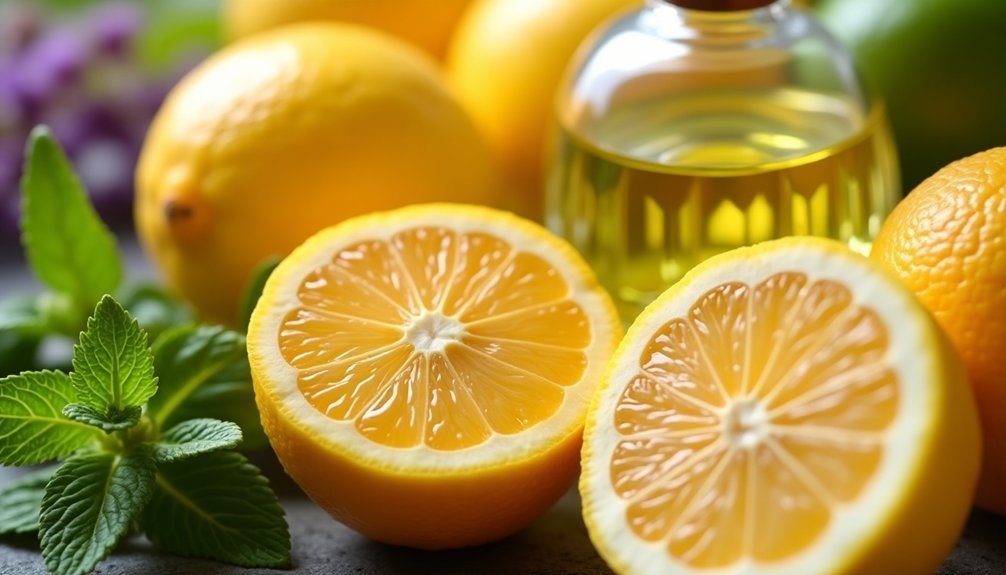
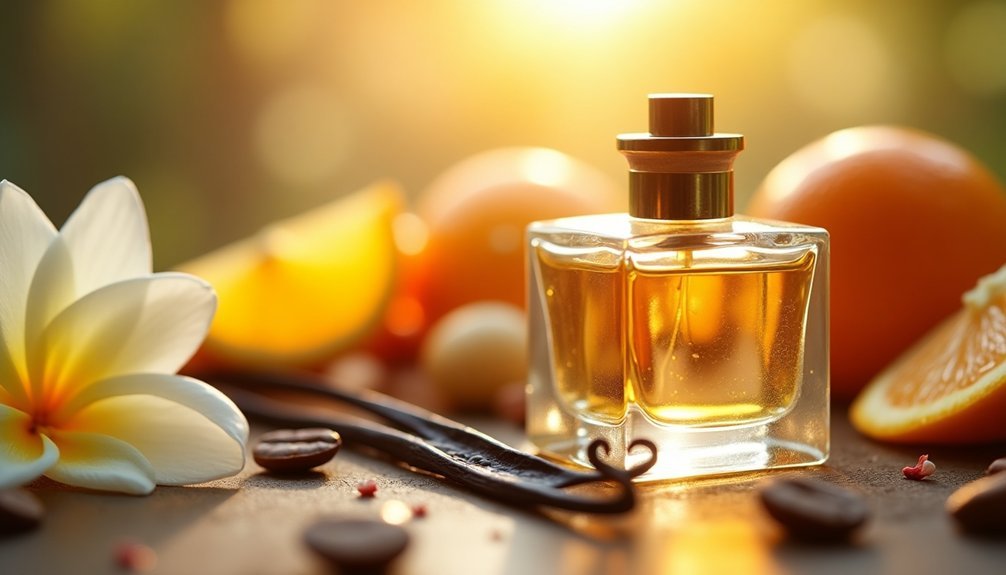
Leave a Reply